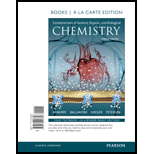
Concept explainers
(a)
Interpretation:
Level of protein structure determined by peptide bond between the amino acid is to be identified.
Concept introduction:
Level of Protein structure,
- Primary structure
- Secondary structure
- Tertiary structure
- Quaternary structure
Primary structure is the sequence of amino acid connected by peptide bond in a polypeptide chain.
(b)
Interpretation:
Level of protein structure determined by hydrogen bonds is to be identified.
Concept introduction:
Secondary structure is the arrangement of polypeptide chain, in a regular pattern of
(c)
Interpretation:
Level of protein structure determined by R group interaction is to be identified.
Concept introduction:
Tertiary structure is the folding of a single protein into a specific three dimensional shape, held by noncovalent interaction between the side chains.
Want to see the full answer?
Check out a sample textbook solution
Chapter 18 Solutions
Modified Masteringchemistry With Pearson Etext -- Valuepack Access Card -- For Fundamentals Of General, Organic, And Biological Chemistry
- Which of the following levels of protein structure may be affected by hydrogen bonding? (a) primary and secondary (b) primary and tertiary (c) secondary, tertiary, and quaternary (d) primary, secondary, and tertiary (e) primary, secondary, tertiary, and quaternaryarrow_forwardAt what level of protein structure do multiple polypeptide chains interact?arrow_forwardDescribe as completely as possible, the four levels of protein What type of bonds hold a protein together at the primary level? What type of bonds maintain the protein at the secondary and tertiary level? Give an example of secondary, tertiary, and quarternary level proteins. At which level is the protein functional? What happens (at a molecular level) when a protein is denatured?arrow_forward
- Protein structure is determined solely by a protein’s amino acid sequence. Should a genetically engineered protein in which the original order of all amino acids is reversed have the same structure as the original protein?arrow_forwardwhat are the four interactions that keep the protein structure intact?arrow_forwardlist the structural organization for the most complex of proteins, and what are they (in the correct order)?arrow_forward
- Why do small proteins have more difficulty folding and holding shape than larger proteins? If you were designing a small protein, what elements of structure might you include to increase protein stability?arrow_forwardHemoglobin is a tetramer consisting of two a and two b chains. What level of protein structure is described in the above statement?arrow_forwardWhat is the importance of each protein structure (Primary, Secondary, Tertiary, and Quaternary structure)?arrow_forward
- what are the key factors determining protein structure?arrow_forwardGlobular proteins are typically constructed from several layers of secondary structure, with a hydrophobic core and a hydrophilic surface. Is this true for a fibrous protein such as keratin?arrow_forwardWhat are the major properties that distinguish different amino acids from one another? What roles do these differences play in the structure and function of proteins?arrow_forward
 Biology (MindTap Course List)BiologyISBN:9781337392938Author:Eldra Solomon, Charles Martin, Diana W. Martin, Linda R. BergPublisher:Cengage Learning
Biology (MindTap Course List)BiologyISBN:9781337392938Author:Eldra Solomon, Charles Martin, Diana W. Martin, Linda R. BergPublisher:Cengage Learning Human Biology (MindTap Course List)BiologyISBN:9781305112100Author:Cecie Starr, Beverly McMillanPublisher:Cengage Learning
Human Biology (MindTap Course List)BiologyISBN:9781305112100Author:Cecie Starr, Beverly McMillanPublisher:Cengage Learning

